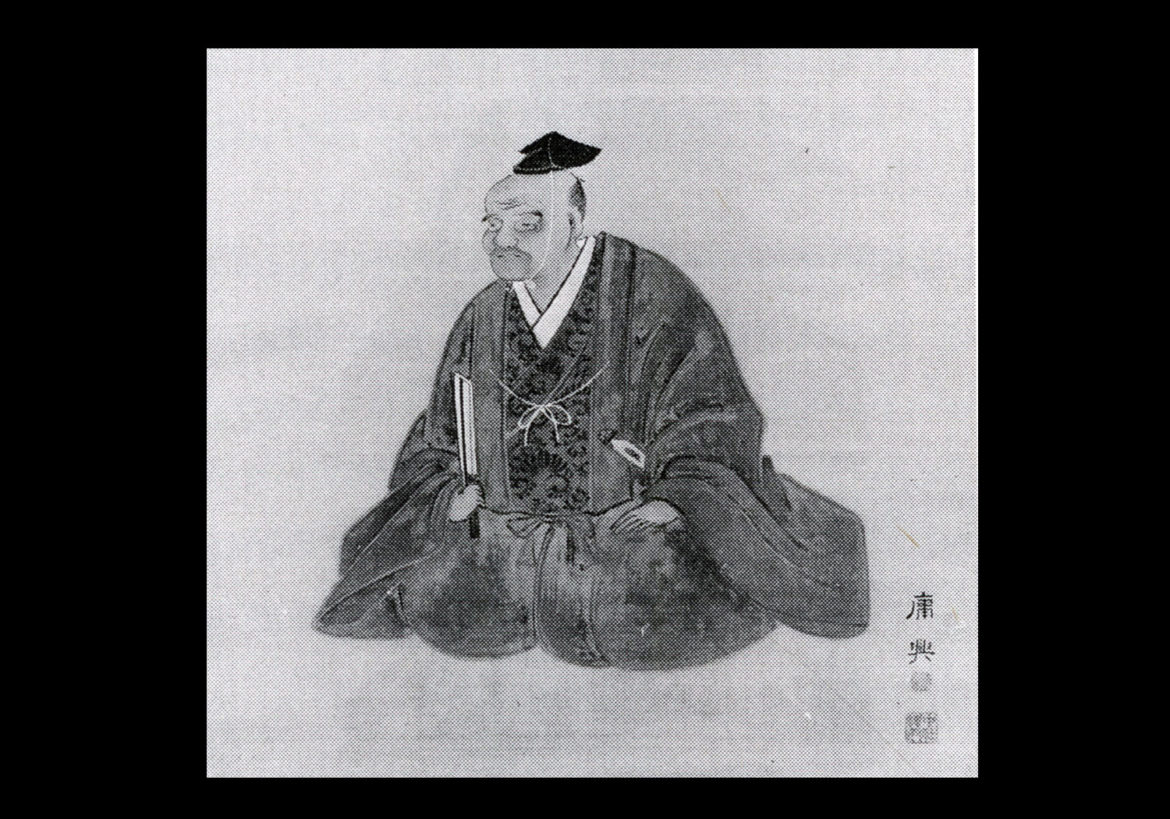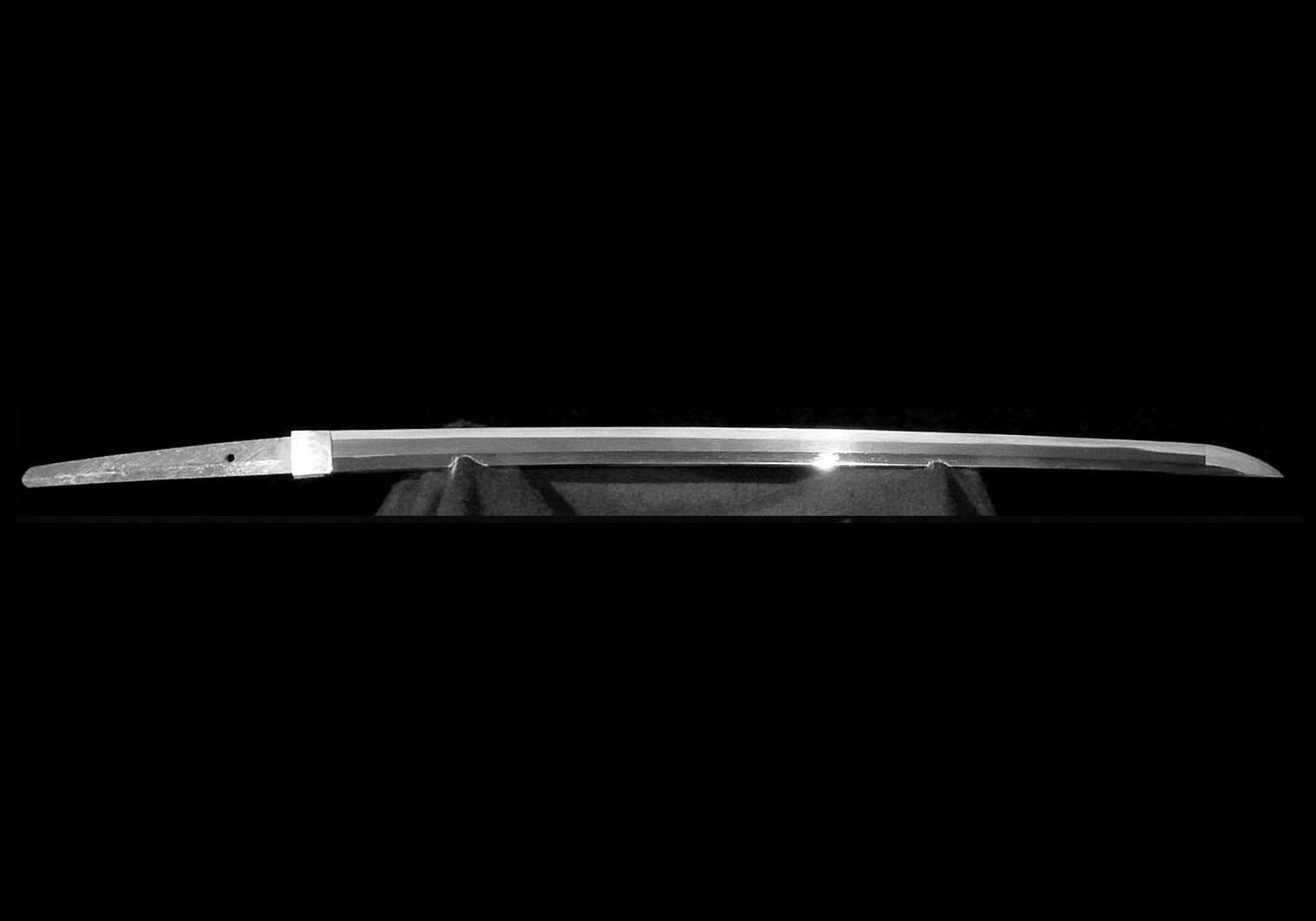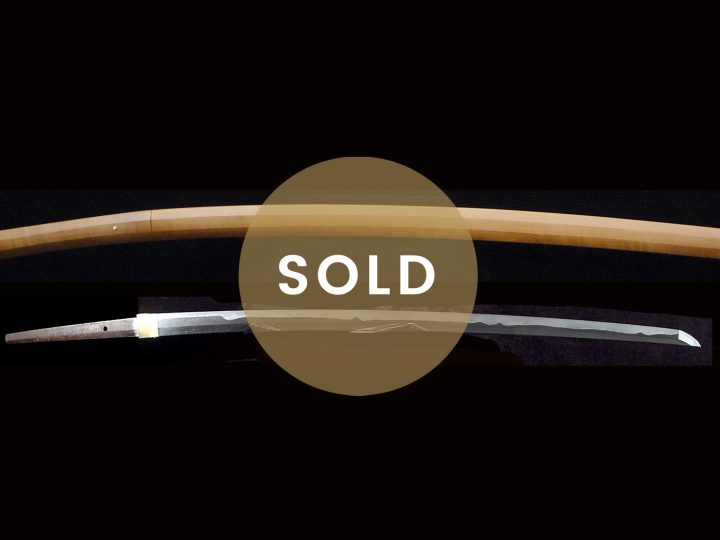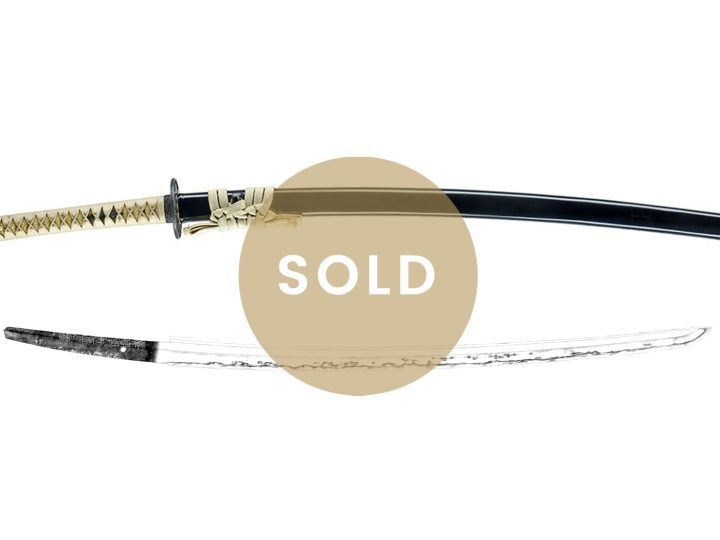
GASSAN SADAYOSHI (月山貞吉)
Gassan Sadayoshi (月山貞吉) was born in 1780 in Dewa province and he was a descendant of the Gassan school of Koto times. When he was born, however, the school had nearly gone as it had been fading out of existence since the beginning of the Edo period. He went to Edo to study under Suishinshi Masahide (水心子正秀) who was working hard to restore the koto traditions. Upon the passing of Masahide (正秀), Sadayoshi (貞吉) moved to Osaka. This was around 1825. After moving to Osaka, he re-established the Gassan school of the Koto period and his students and descendants have re-energized this school so that it still exists today under the modern smith, Gassan Sadatoshi (月山貞寿).
Sadayoshi (貞吉) was able to re-create the famous Gassan ayasugi hada and he made it the foundation of the newly re-energized Dewa Gassan school that was located in Osaka. He was also adept at creating the masame-hada of the Yamato school and dense mokume-hada. His styles of hamon include chu-suguha in nie deki, small patterned choji midare, koshi-no-hirata midare, and others.
Gassan Sadayoshi (月山貞吉) became a master in Yamashiro and Bizen styles as well as the Gassan style. His son and grandson added a mastery of Soshu den and Yamato den, thus becoming fluent in all the top styles of sword crafting. Toward the end of his life, Sadakazu (貞一) would make daimei for Sadayoshi (貞吉) and this is something that continued when Sadakazu (貞一) himself became elderly and his son, Sadakatsu (貞勝), took over the main roles in the workshop. In other words, Sadakazu (貞一) and Sadakazu (貞一) produced swords by themselves but signed the blades with his father’s name.
Sadayoshi (貞吉) trained many well-known pupils in addition to his adopted son, Sadakazu (貞勝). Some of the most famous were Kusano Yoshiaki (草野吉明), Sugimoto Sadahide (杉本貞秀), and Horii Taneyoshi (堀井胤吉). There are references attesting to Sadayoshi (貞吉) having trained pupils to be proficient enough to leave the master’s workshop and be on their own by the time Sadakazu (貞一) was adopted in 1843. This is evident from the pledges written by Sadayoshi’s (貞吉) two senior pupils as they were gaining independence in 1843 and 1867 stating that they would never disclose the secrets they had learned from their master.
Sadayoshi (貞吉) died at the age of 71 (70 accordingly to the occidental was of counting age) in the third year of Meiji (1870).
GASSAN SADAKAZU (月山貞一)
Gassan Sadakazu (月山貞一) was born in 1836 in Sugoshi Village in Omi Province. His real name was Yagoro. He was the son of Tsukamoto Shichirobei (塚本七郎兵衛). When he was seven years old, he was adopted into the Gassan family as the heir of Gassan Sadayoshi (月山貞吉) who’s only living heir died prematurely. At various times he took the names Unjisai, Kokensai, and Suiyushi.
Sadakazu (貞一) started studying the art of sword making at about age 11. He made his first sword at age 14 and by age 20 was recognized as a top quality sword smith and horimono carver. One blade that he made at the age of 14 has been confirmed. Sadakazu’s (貞一) career as a sword smith spanned more than 70 years.
In 1907 he was nominated as Teishitsu Gigei In (帝室技芸員) (Craftsman authorized by the Imperial court). This was a title equivalent to today’s Living National Treasure.
About this time he produced a number of swords in the Bizen or Yamato style in addition to the main ayasugi tradition. His blade structure featured a modest curvature and a pronounced large boshi with only a slightly rounded edge (fukura-kareru). These were also characteristics of Sadayoshi’s (貞吉) work.
He was familiar with all of the sword-smithing traditions and was especially good at Soshu and Bizen traditions. He was also one of the best engravers of Shinshinto times. His horimono is admired as much as that of Honjo Yoshitane (本荘義胤) and Kurihara Nobuhide (栗原信秀).
For the most part, work stopped for Sadakazu (貞一) in 1876 when the wearing of swords was abolished with the issuance of the Haitorei. There is said to have been almost no commissioned work available during this period. Sword making did not resume in earnest until around 1887 when Japan went to war with China and the demand for swords resumed. During this interim period of limited production, Sadakazu (貞一) eked out an existence and kept his sword making skills honed by making “replicas” of ancient masterful works. Many of these “replicas” ended up in European collections where they were thought to be genuine.
Sadakazu (貞一) trained many noteworthy pupils such as Takahashi Nobuhide (高橋信秀) and Morioka Masayoshi (森岡正吉), in addition to his son Sadakatsu (貞勝).
He died in 1918 after a long and very distinguished career as one of the premier sword makers of the 19th and 20th centuries.
Some of the basic characteristics of the Dewa Gassan school are as follows:
SUGATA: The blades generally exhibit a long nagasa, shallow sori, a wide mihaba, chu-kissaki or o-kissaki, and a grand sugata. There are also sugata in the style of the early Muromachi period. Around the Keio era, Sadakazu’s (貞一) sugata tends to become especially grand. He made many copies of koto blades.
JIGANE: Ayasugi-hada in his school’s best known tradition and the school’s trademark. There are also masame-hada of the Yamato tradition, mokume-hada, ko-mokume hada, itame-hada, etc. Various jihada can be seen, each appropriate to the tradition of a particular blade.
HAMON: You will find skillful chôji midare consisting of nioi with a narrow yakiba and long nioi ashi copied from Ôei-Bizen smiths; ko-chôji midare consisting of ko-nie, chu-suguha hotsure of the Yamashiro tradition; or gunome midare of the Soshu tradition consisting of thick nioi and nie with a good deal of hataraki.
BÔSHI: Ko-maru, midare-komi, yakitsume, etc.
HORIMONO: These include various designs such as dragons, plums and dragons, ken-maki-ryu, waterfalls, Fudo Myoo, and bonji, etc. All are engraved elaborately and skillfully, occasionally resembling the work of Ikkanshi Tadatsuna (一竿子忠綱).
NAKAGO: They will be long with kurijiri. The yasurimei will be sujikai with kesho-yasuri. The nakago is carefully finished with ippon yasuri.
The blade shown above is a beautiful katana by Gassan Sadahide (月山貞秀). Sadahide (貞秀) was a student of Gassan Sadayoshi (月山貞吉) and a contemporary of Gassan Sadakazu (月山貞一). His works are much scarcer that those of his contemporary, Sadakazu (貞一). This blade bears the typical characteristics taught to Sadahide (貞秀) by his teacher Gassan Sadayoshi (月山貞吉). His given name was Sugimoto Kônoshin (杉本廣之進) and his original kuni was Dewa (出羽).
This sword bears a sayagaki by Tanobe sensei that reads as follows:
Sesshu Amasaki Ju Unzen-shi Sadahide in a six-character signature and dated Ansei 2 nen (1856). Sword was custom ordered by Konishi Yukiya. Sadahide was a student of Gassan Sadayoshi. This sword has a magnificent appearance because of its shape and dimensions. It exhibits a thick suguha with kinsuji. The deki is highly dignified. Length is 2 shaku 3 sun 8 bu.
Sayagaki signed by Tanzan Hendo (pseudonym or art name of Tanobe Michihiro) in the year of the horse 2014.
The actual signature on the sword is Unzenshi Sadahide Tsukuru (雲仙子貞秀作). The ura is dated Ansei Ni Nen Ni Gatsu Kichi Nichi (安政二年二月吉日) (Made on a lucky day in February of 1856). Tame Yukiya Konishi Kun Kitaeru Kore (為雪屋小西君鍛之) (This was forged for Mr. Yukiya Konishi).
This sword is an excellent example of the Dewa Gassan school. As noted, the nagasa is 72.2 cm or 28 7/16 inches. It has a shallow tori sori and an extended kissaki. Overall it is a grand sugata as was typical of Sadayoshi (貞吉) and his students. The hamon is a hoso-suguha with a bright nioi guchi that is covered in nie. There are kinsuji and other hataraki within the hamon. The hada is a vibrant mokume and there are areas of what can only be called a form of ayasugi. The nakago is beautifully finished and elegantly signed.
It is interesting to know that the person who ordered this blade was a merchant from the Konishi family. Certainly, before the waning of the Samurai era no one except a member of the Samurai class could have owned and carried a blade of this length. The Konishi family was well established as merchants who moved from Kyoto to Osaka around this time (Ansei). The Konishi family business began with pharmaceuticals and expanded into alcohol. The family business still exists today. Some of their early buildings have been preserved as historically significant buildings.







